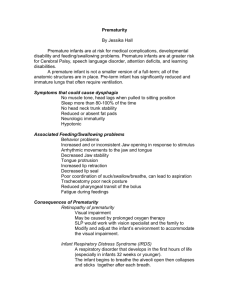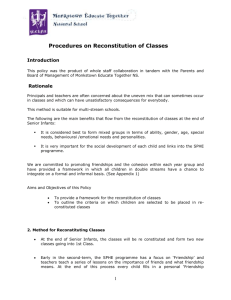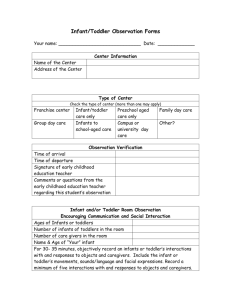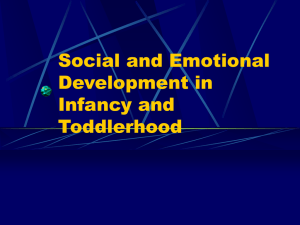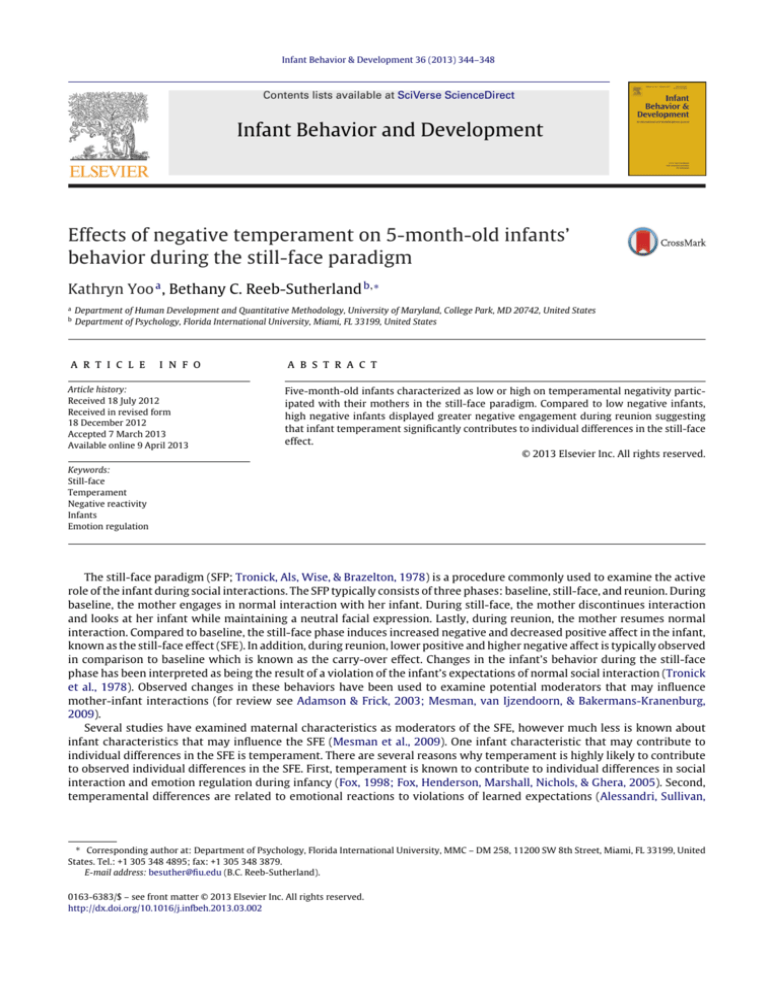
Infant Behavior & Development 36 (2013) 344–348
Contents lists available at SciVerse ScienceDirect
Infant Behavior and Development
Effects of negative temperament on 5-month-old infants’
behavior during the still-face paradigm
Kathryn Yoo a , Bethany C. Reeb-Sutherland b,∗
a
b
Department of Human Development and Quantitative Methodology, University of Maryland, College Park, MD 20742, United States
Department of Psychology, Florida International University, Miami, FL 33199, United States
a r t i c l e
i n f o
Article history:
Received 18 July 2012
Received in revised form
18 December 2012
Accepted 7 March 2013
Available online 9 April 2013
a b s t r a c t
Five-month-old infants characterized as low or high on temperamental negativity participated with their mothers in the still-face paradigm. Compared to low negative infants,
high negative infants displayed greater negative engagement during reunion suggesting
that infant temperament significantly contributes to individual differences in the still-face
effect.
© 2013 Elsevier Inc. All rights reserved.
Keywords:
Still-face
Temperament
Negative reactivity
Infants
Emotion regulation
The still-face paradigm (SFP; Tronick, Als, Wise, & Brazelton, 1978) is a procedure commonly used to examine the active
role of the infant during social interactions. The SFP typically consists of three phases: baseline, still-face, and reunion. During
baseline, the mother engages in normal interaction with her infant. During still-face, the mother discontinues interaction
and looks at her infant while maintaining a neutral facial expression. Lastly, during reunion, the mother resumes normal
interaction. Compared to baseline, the still-face phase induces increased negative and decreased positive affect in the infant,
known as the still-face effect (SFE). In addition, during reunion, lower positive and higher negative affect is typically observed
in comparison to baseline which is known as the carry-over effect. Changes in the infant’s behavior during the still-face
phase has been interpreted as being the result of a violation of the infant’s expectations of normal social interaction (Tronick
et al., 1978). Observed changes in these behaviors have been used to examine potential moderators that may influence
mother-infant interactions (for review see Adamson & Frick, 2003; Mesman, van Ijzendoorn, & Bakermans-Kranenburg,
2009).
Several studies have examined maternal characteristics as moderators of the SFE, however much less is known about
infant characteristics that may influence the SFE (Mesman et al., 2009). One infant characteristic that may contribute to
individual differences in the SFE is temperament. There are several reasons why temperament is highly likely to contribute
to observed individual differences in the SFE. First, temperament is known to contribute to individual differences in social
interaction and emotion regulation during infancy (Fox, 1998; Fox, Henderson, Marshall, Nichols, & Ghera, 2005). Second,
temperamental differences are related to emotional reactions to violations of learned expectations (Alessandri, Sullivan,
∗ Corresponding author at: Department of Psychology, Florida International University, MMC – DM 258, 11200 SW 8th Street, Miami, FL 33199, United
States. Tel.: +1 305 348 4895; fax: +1 305 348 3879.
E-mail address: besuther@fiu.edu (B.C. Reeb-Sutherland).
0163-6383/$ – see front matter © 2013 Elsevier Inc. All rights reserved.
http://dx.doi.org/10.1016/j.infbeh.2013.03.002
K. Yoo, B.C. Reeb-Sutherland / Infant Behavior & Development 36 (2013) 344–348
345
& Lewis, 1990; Fagen & Ohr, 1985). Lastly, some temperament assessments include measures of emotional reactivity to
violations of social norms (Goldsmith & Rothbart, 1999). Given the likely link between temperament and the SFE, it is somewhat surprising that only a few studies have examined this relation (Braungart-Rieker, Garwood, Powers, & Notaro, 1998;
Conradt & Ablow, 2010; Haley & Stansbury, 2003; Tarabulsy et al., 2003). The majority of these studies have reported no
association between temperament and behaviors observed during the SFP (Conradt & Ablow, 2010; Haley & Stansbury, 2003;
Tarabulsy et al., 2003), while one study has reported that negative temperament is associated with reduced regulatory behaviors during the SFP (Braungart-Rieker et al., 1998). Additionally, other studies have included measures of both temperament
and the SFP in their battery of assessments, but did not examine the relation between the two constructs (Cohn, Campbell,
& Ross, 1991; Fuertes, Lopes dos Santos, Beeghly, & Tronick, 2007). The paucity of research and inconsistent findings among
these studies suggests that additional research is needed to determine temperamental contributions to the SFE.
Most models of temperament include some aspect of negative reactivity (Calkins, Fox, & Marshall, 1996; Goldsmith et al.,
1987; Kagan & Snidman, 1991) which describes an infant’s tendency to display signs of distress (i.e., crying, fussing, motoric
agitation). Maternal report of temperamental negative reactivity has been shown to be positively related to infants’ displays
of greater negative affect (i.e., fussiness, crying) when there was a violation of learned expectancy (Fagen & Ohr, 1985)
suggesting that similar temperamental characteristics may predict infants’ negative affect in responding to the expectancy
violation produced by the SFP. It has been suggested that infants who display extreme levels of negative reactivity are
categorically different in their temperamental profile than infants who display low levels of negative reactivity (Calkins
et al., 1996; Kagan & Snidman, 1991) and that categorical models of temperamental negative reactivity are better predictors
of later behavior than continuous models (Woodward, Lenzenweger, Kagan, Snidman, & Arcus, 2000). Previous studies
examining temperamental influences on the SFE have utilized continuous rather than categorical measures of temperament
which may help explain why the vast majority of studies report no temperament-SFE relation, particularly when considering
negative reactivity. Therefore, in the current study, a categorical approach was taken by examining behavioral responses
during the SFP in infants categorized as high on maternal report of negative reactivity compared to infants categorized as
low on maternal report of negative reactivity.
Participants were seen as part of a longitudinal investigation exploring the relation between early associative learning
and development of social behavior during the first two years of life. Eighty-five 5-month-old infants (43 male, M age = 5.19
months, SD = .53 months) and their mothers participated in the current study. Infants’ behavioral responses during the
SFP (Tronick et al., 1978) were examined in relation to maternal report of infants’ temperament via the Infant Behavior
Questionnaire (IBQ; Rothbart, 1981).
The IBQ (Rothbart, 1981) requires mothers to rate the frequency of their infants’ behaviors across a number of temperamental dimensions, including activity, soothability, distress to limitations, fear, and smiling/laughter. Following previous
studies (Henderson, Fox, & Rubin, 2001; Rothbart, 1986), distress to limitations and fear subscales were standardized and
summed as an index of Negative Reactivity. Two groups of infants were created: high negative (n = 29, 15 male) and low
negative (n = 31, 16 male). High and low negative infants’ Negative Reactivity scores were in the top and bottom third of the
sample, respectively.
During the SFP, the infant was placed in an infant seat facing the mother and the infant’s behaviors were videotaped. The
SFP consisted of three 2-minute phases: baseline, still-face, and reunion. During the baseline and reunion phases, the mother
interacted with her infant as she normally would without the use of toys. During the still-face phase, the mother looked
at the infant without smiling, talking, or touching the infant. Infants’ behaviors were coded using the Infant and Caregiver
Engagement Phases system (ICEP; Weinberg & Tronick, 1999) which includes a set of mutually exclusive infant and mother
phases of interactive engagement and regulatory codes which are coded second-by-second. For the infant, behavioral codes
include protest, withdrawn, object/environment engagement, social monitor, social positivity, and oral self-comforting.
Percentage of time each behavior was displayed was computed by dividing the total time the behavior occurred by the total
time of the phase and multiplied by 100. Negative engagement was defined as the sum of protest and withdrawn behaviors
as previously suggested (Tronick et al., 2005; Weinberg & Tronick, 1999). Emotion regulation was defined as the sum of
object/environment engagement and oral self-comforting. Inter-rater reliability was obtained on 20% of the data by two
independent coders (range for ˛’s: .78–.99).
Data from the whole sample (n = 60) was examined for violations of normality and equal variance assumptions. If detected,
outliers were removed prior to data analysis. An infant was determined to be an outlier if he or she was at least 2 standard
deviations above or below the sample mean and if this trend was found consistently across all phases of the SFP. Given this
definition, 3 low negative infants were excluded from current analyses due to excessive displays of negative engagement.
Separate repeated measures ANOVAs were conducted for each of the four engagement behaviors (negative engagement,
social positivity, emotion regulation, and social monitoring) with Phase (baseline, still-face, reunion) as the within factor
and Group (low negative, high negative) as the between factor. Preliminary analysis determined that no sex effects existed
and was, therefore, not included in further analyses.
Fig. 1 displays behavioral patterns during the SFP between low and high negative infants. A significant phase × group
interaction effect was found for negative engagement (F(1,55) = 5.675, p = .021, 2 = .094, linear trend) showing that high and
low negative infants significantly differed in their display of negative engagement across the three phases (Fig. 1a). Followup independent samples t-tests revealed that both groups of infants responded similarly during the baseline (t(55) = −1.311,
p = .20, d = .354) and still-face (t(55) = −1.607, p = .12, d = .433) phases, however during the reunion phase, high negative
infants displayed significantly greater negative engagement compared to the low negative infants (t(55) = −2.533, p = .017,
346
K. Yoo, B.C. Reeb-Sutherland / Infant Behavior & Development 36 (2013) 344–348
Fig. 1. Effects of negative reactivity on infants’ behavior during the still-face paradigm. (a) Infants reported as having high levels of temperamental negative
reactivity (high negative, solid line) displayed negative engagement behaviors more often during the reunion phase compared to infants reported as having
low levels of temperamental negative reactivity (low negative, dashed line). High and low negative infants did not differ on displays of (b) social positivity,
(c) emotion regulation, or (d) social monitoring. *p < .05.
d = .683). Paired samples t-tests revealed that high and low negative infants both displayed the typical SFE in negative
engagement, showing a significant increase if negative engagement from the baseline to the still-face phase (high negative:
t(28) = −2.726, p = .011, d = 1.030; low negative: t(27) = −2.834, p = .009, d = 1.091). However, only the low negative infants
showed a tendency to decrease in negative engagement from the still-face phase to the reunion phase (t(27) = 1.959, p = .061,
d = .754). In contrast, the high negative infants’ negative engagement did not differ between the still-face and reunion phases
(t(28) = −.008, p = .993, d = .003). In comparison to the baseline phase, the high negative infants displayed significantly greater
negative engagement during the reunion phase (t(28) = −2.806, p = .009, d = 1.061) while the low negative infants displayed
no difference between the two phases (t(27) = −1.842, p = .10, d = .709).
Similar analyses were conducted for emotion regulation, social positivity, and social monitoring. No significant interaction effects or main effects of group were found. However, as previously reported, a significant main effect of phase was
found for each behavior (social positivity: F(2,110) = 30.726, p < .001, 2 = .358, Fig. 1b; emotion regulation: F(2,110) = 27.227,
p < .001, 2 = .331, Fig. 1c; social monitoring: F(2,110) = 13.489, p < .001, 2 = .197, Fig. 1d). Between the baseline and still-face
phases, infants exhibited a significant decrease in social positivity (t(56) = 6.392, p < .001, d = 1.708) and social monitoring
(t(56) = 4.951, p < .001, d = 1.323) as well as a significant increase in emotion regulation (t(56) = −6.018, p < .001, d = 1.608). In
contrast, infants displayed a significant increase in social positivity (t(56) = −6.236, p < .001, d = 1.667) and social monitoring
(t(56) = −2.675, p = .010, d = .715), but a significant decrease in emotion regulation (t(56) = 6.435, p < .001, d = 1.720) between
the still-face and reunion phases. A significant decrease in social monitoring was observed between the baseline and reunion
phases (t(56) = 2.739, p = .008, d = .732) while no differences between baseline and reunion were observed for either social
positivity (t(56) = −.481, p = .632, d = .129) or emotion regulation (t(56) = .382, p = .704, d = .043).
The aim of the current study was to investigate the specific contributions of infant temperamental negative reactivity to
behavioral differences observed during the SFP. We found that infants who were rated by their mothers as high on negative
reactivity displayed increased negative engagement during the reunion phase compared to infants rated as low on negative
reactivity. Furthermore, high negative infants did not show a difference in their negative engagement between the stillface and reunion phases suggesting that there was a lack in recovery or decrease of negative affect even after the mother
K. Yoo, B.C. Reeb-Sutherland / Infant Behavior & Development 36 (2013) 344–348
347
attempted reengagement with her infant. Overall, these findings suggest that negative temperamental biases contribute to
the infant’s recovery of negative affect following a socially stressful and unexpected situation.
Previous research examining the SFP in typically developing infants have described a phenomenon known as the carryover effect (Tronick et al., 1978) in which infants continue to display increased negative and decreased positive affect
during the reunion phase compared to the baseline phase. In the current study, only the high negative infants displayed
a significant increase in negative affect during the reunion phase compared to the baseline phase. In contrast, the low
negative infants displayed no difference in negative affect between the baseline and reunion phases. In addition, neither
group showed differences in positive affect between the baseline and reunion phases. Therefore, these results demonstrate
that only the high negative infants displayed a partial carry-over effect for negative and not positive affect suggesting that
perhaps the classic carry-over effect observed among typically developing infants can be significantly influenced by the
infant’s temperamental negativity.
The few studies that have examined temperamental contributions have reported relatively inconsistent findings. Specifically, three studies found no direct contributions of temperament to the SFE (Conradt & Ablow, 2010; Haley & Stansbury,
2003; Tarabulsy et al., 2003) while one study reported an association between negative temperament and behaviors during
the still-face phase (Braungart-Rieker et al., 1998). The current study contributes to these few studies by demonstrating a
relation between maternally reported negative reactivity and negative engagement during the reunion phase. BraungartRieker and colleagues (1998) reported that high temperamental negativity was not associated with negative affect during
the SFP, but was associated with decreased self-comforting and object orientation during the still-face phase. In contrast,
we found that extreme levels of temperamental negative reactivity were associated with negative affect during the SFP,
particularly during the reunion phase, but was not associated with emotion regulation (i.e., sum of oral self-comforting and
object/environment engagement). The inconsistencies observed between these findings may be the result of a number of
factors including the use of different measures of temperamental negativity, different statistical approaches (examining
continuous vs. categorical measures of temperament), as well as different coding schemes for observing infant behaviors.
In addition, other infant factors may contribute to differences among findings including the age of the infant sample as
well as sex distribution. To further understand the influence of temperament on infants’ behavioral responses during the
SFP, additional research needs to be conducted using consistent measures of temperament as well as consistent behavioral
measures.
Previous research has shown that temperamental negative reactivity is associated with decreased abilities to regulate
emotions (Calkins & Fox, 2002). Contrary to these findings, we did not find any difference in measures of emotion regulation
during the SFP between low and high negative infants. However, although these differences were not significant, it is worth
noting that the high negative infants were consistently lower in emotion regulation across the SFP compared to the low
negative infants. It is possible that the two-minute windows in each of the phases were not sufficiently long enough to reveal
significant differences in emotion regulation between the low and high negative infants.
The current study is not without limitations. One limitation is the use of maternal report for the assessment of temperament. It has been suggested that maternal report of infant temperament is not an accurate assessment of the infant’s
temperamental behavior because the mother’s own beliefs and perceptions can bias how she rates her own infant’s temperament and that the use of behavioral measures may supply a more objective measure of temperament (Kagan & Fox, 2006).
Although it should be noted that behavioral measures of negative reactivity have been shown to be highly correlated with
maternal reports of negative reactivity (Calkins et al., 1996). Nevertheless, future studies examining the relation between
extreme temperamental characteristics, like negative reactivity, and the SFP should include behavioral measures of temperament. In addition, the current study was limited to the examination of 5-month-old infants; therefore, we are unable to
address whether the temperamental differences observed in negative engagement may be observed at earlier or later ages
or whether temperamental effects are stable across infancy. Future studies should examine these important questions.
The current study provides evidence that infant negative temperament significantly influences the SFE suggesting that
infants are active contributors to changes in social interactions during the SFP. Considering individual differences in infant
temperament in the SFE can help reveal the dyadic complexities between the infant and the caregiver that are embedded
in the SFP. In the future, noting these individual differences may potentially be useful when examining other moderators of
the SFE.
Acknowledgements
This project was supported by NIMH grant MH 080759 to Pat Levitt and Nathan Fox. The authors would like to thank the
infants and their families for their participation in our study. A fuller report of the study will be provided upon request.
References
Adamson, L. B., & Frick, J. E. (2003). The still face: A history of a shared experimental paradigm. Infancy: 4., 451–473.
Alessandri, S. M., Sullivan, M. W., & Lewis, M. (1990). Violation of expectancy and frustration in early infancy. Developmental Psychology: 26., 738–744.
Braungart-Rieker, J., Garwood, M. M., Powers, B. P., & Notaro, P. C. (1998). Infant affect and affect regulation during the still-face paradigm with mothers
and fathers: The role of infant characteristics and parental sensitivity. Developmental Psychology: 34., 1428–1437.
Calkins, S. D., & Fox, N. A. (2002). Self-regulatory processes in early personality development: A multilevel approach to the study of childhood social
withdrawal and aggression. Development and Psychopathology: 14., 477–498.
348
K. Yoo, B.C. Reeb-Sutherland / Infant Behavior & Development 36 (2013) 344–348
Calkins, S. D., Fox, N. A., & Marshall, T. R. (1996). Behavioral and physiological antecedents of inhibited and uninhibited behavior. Child Development: 67.,
523–540.
Cohn, J. F., Campbell, S. B., & Ross, S. (1991). Infant responses in the still-face paradigm at 6 months predicts avoidant and secure attachment at 12 months.
Development and Psychopathology: 3., 367–376.
Conradt, E., & Ablow, J. (2010). Infant physiological response to the still-face paradigm: Contributions of maternal sensitivity and infants’ early regulatory
behavior. Infant Behavior & Development: 33., 251–265.
Fagen, J. W., & Ohr, P. S. (1985). Temperament and crying in response to the violation of a learned expectancy in early infancy. Infant Behavior & Development:
8., 157–166.
Fox, N. A. (1998). Temperament and regulation of emotion in the first years of life. Pediatrics: 102., 1230–1235.
Fox, N. A., Henderson, H. A., Marshall, P. J., Nichols, K. E., & Ghera, M. M. (2005). Behavioral inhibition: Linking biology and behavior within a developmental
framework. Annual Review of Psychology: 56., 235–262.
Fuertes, M., Lopes dos Santos, P., Beeghly, M., & Tronick, E. (2007). More than maternal sensitivity shapes attachment – Infant coping and temperament.
Annals of the New York Academy of Sciences: 1094., 292–296.
Goldsmith, H. H., Buss, A. H., Plomin, R., Rothbart, M. K., Thomas, A., Chess, S., et al. (1987). Roundtable: What is temperament? Four approaches. Child
Development: 58., 505–529.
Goldsmith, H. H., & Rothbart, M. K. (1999). Laboratory temperament assessment battery (Lab-TAB): Pre-locomotor version 3.1. Department of Psychology,
University of Oregon.
Haley, D. W., & Stansbury, K. (2003). Infant stress and parent responsiveness: Regulation of physiology and behavior during still-face and reunion. Child
Development: 74., 1534–1546.
Henderson, H. A., Fox, N. A., & Rubin, K. (2001). Temperamental contributions to social behavior: The moderating roles of frontal EEG asymmetry and
gender. Journal of the American Academy of Child & Adolescent Psychiatry: 40., 68–74.
Kagan, J., & Fox, N. A. (2006). Biology, culture, and temperamental biases. In W. Damon, & R. M. Lerner (Series Eds.) &, Handbook of child psychology : Vol. 3.
(pp. 167–225). New York: Wiley.
Kagan, J., & Snidman, N. (1991). Temperamental factors in human development. American Psychologist: 46., 856–862.
Mesman, J., van Ijzendoorn, M. H., & Bakermans-Kranenburg, M. J. (2009). The many faces of the Still-Face Paradigm: A review and meta-analysis.
Developmental Review: 29., 120–162.
Rothbart, M. K. (1981). Measurement of temperament in infancy. Child Development: 65., 1503–1515.
Rothbart, M. K. (1986). Longitudinal observation of infant temperament. Developmental Psychology: 22., 356–365.
Tarabulsy, G. M., Provost, M. A., Deslandes, J., St-Laurent, D., Moss, E., Lemelin, J.-P., et al. (2003). Individual differences in infant still-face response at 6
months. Infant Behavior & Development: 26., 421–438.
Tronick, E. Z., Als, H., Wise, S., & Brazelton, T. B. (1978). The infant’s response to entrapment between contradictory messages in face-to-face interaction.
Journal of the American Academy of Child & Adolescent Psychiatry: 17., 1–13.
Tronick, E. Z., Messinger, D. S., Weinberg, M. K., Lester, B. M., Lagasse, L., Seifer, R., et al. (2005). Cocaine exposure is associated with subtle compromises
of infants’ and mothers’ social–emotional behavior and dyadic features of their interaction in the face-to-face still-face paradigm. Developmental
Psychology: 41., 711–722.
Weinberg, M. K., & Tronick, E. Z. (1999). Infant and caregiver engagement phases system. Boston: Children’s Hospital and Harvard Medical School.
Woodward, S. A., Lenzenweger, M. F., Kagan, J., Snidman, N., & Arcus, D. (2000). Taxonic structure of infant reactivity: Evidence from a taxometric perspective.
Psychological Science.




